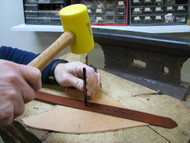Leather Hole Punch For Belts & Leatherwork
Which Type of Leather Hole Punch?
This post covers the best methods for making holes for belts and other leatherwork projects, using several different types of leather hole punch tools. It will teach you how to use the drive punch, rotary hole punch, oblong hole punch, and four hole punch. The post will also help you choose which leather handtool or leather punch set is the best fit for your leather crafting needs. At the end of the post is a video where you can watch how to make a hole in leather with each different type of leather hole punch.
Round Hole Drive Punch
The drive punch is the most basic, strongest, and most universal type of leather hole punch. They come in a range of sizes. We use our small 3/32 inch leather punch to make holes for small rivets and small jacket snaps, our 1/8 inch drive punch tool to make holes for medium and large rivets, and our 5/32 inch hole punch for large jacket snaps. These sizes can be used for some buckle holes as well, but often the larger hole punch sizes are better for buckles with thicker pins. For this, you will need to choose a punch based on the circumference of your buckle tongue. To make holes for grommets and eyelets, you will need to choose a punch size based on the interior circumference of the eyelet or grommet.

Round drive punches are available in many hole diameters.
You can also find adjustable leather punch sets. These consist of a body that can be fitted with different sizes of removable hole tube tips. Our mini punch set includes six smaller tips, and the maxi punch set has six larger tips. These are a good option if you aren't sure what size you'll need, or if you need to punch multiple sizes of holes. They are a good economical choice if you won't be punching a lot of holes, since you won't have to spend money on many different individual drive punch tools. The disadvantage of this type of punch is that swapping out the ends takes up time.
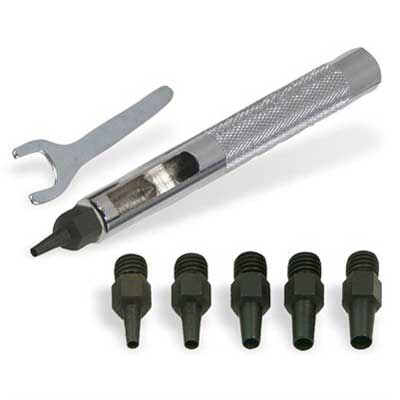
Mini punch set with interchangeable tips and wrench.
How To Use A Drive Punch
To use a drive punch, first start with a sturdy surface that won’t bounce when you’re punching holes. We use a solid tree stump. On top of the stump we lay a piece of scrap leather, so that the sharp point on the drive tool won’t get dull from punching directly onto wood. This also prevents the punch from chewing up the wood and ruining your cutting surface. If you don't have scrap leather available, you can use a poly cutting board.
Use a pencil or scratch awl to mark the leather where you need the hole punched. On darker colored leather it is easier to see a point mark by the awl than a pencil mark. Then set the piece on your cutting surface and line up your punch. The hole punch should be completely perpendicular to the leather. Hold it securely in this position, and hammer straight downwards. Depending on the thickness of the leather, the punch should cut through cleanly with one or two solid blows.

We punch holes on top of a tree stump, with a scrap leather pad to protect the drive punch tool.
The hammer shown in this photo is a large poly head mallet; a heavy rawhide mallet is also a good option. Both materials will absorb bounce, and the softer surface will protect your tools over time and extend their life.
A traditional carpenter's hammer can be used as well. The disadvantage of a metal hammer is that over time it will start to mushroom the end of your hole punch tools, since you are banging metal against metal.
Making Buckle Slots With An Oblong Leather Punch
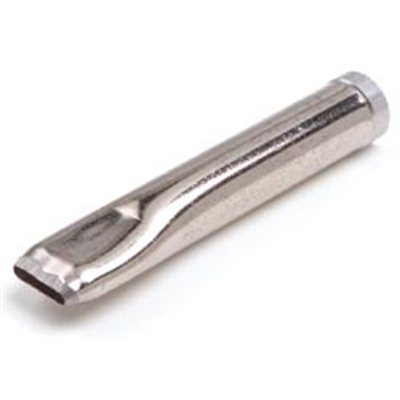
Oblong hole punch, used for the pin hole on belt buckles.
Use the same process to punch an oblong shaped hole for a belt buckle. It may take a bit more hammering than the smaller drive punch. You can tilt the leather oblong punch slightly, if needed, to focus the force of the hammer onto a stubborn spot.
If you can't afford an oblong hole punch when first starting leather craft, you can get around that problem with your round hole punches. Punch two round holes an inch apart, then use a utility knife to make two parallel cuts to join the round holes together. You could also use a wood chisel to make the straight cuts. However once you have the money and use an oblong punch, you will never go back to the work-around method.
For most of our belts and dog collars we use a 1 inch oblong punch. We use larger punches for items with large or bulky buckles, and smaller punches for small items with slender buckles. If you can't afford a number of different sizes of oblong hole punch, you can use the one you already own to make a longer hole. Punch one hole and then overlap the punch on the existing hole, extending it past the existing hole to the desired slot length. Give it a blow with the hammer so the two slots make one longer oblong slot. You can see a poly cutting board being used below to protect the bench and the tool's edge.
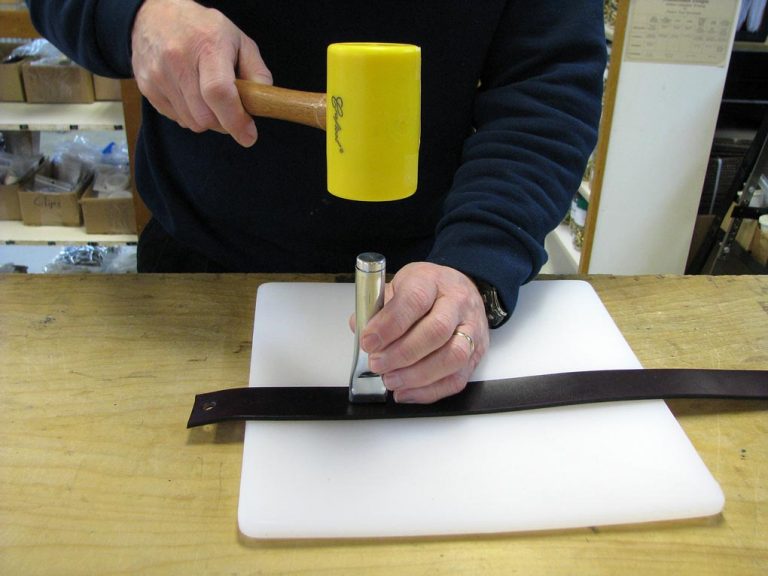
Use an oblong hole punch tool to punch a hole for a belt buckle. Shown with poly cutting board.
Punching Round Holes With A Rotary Punch
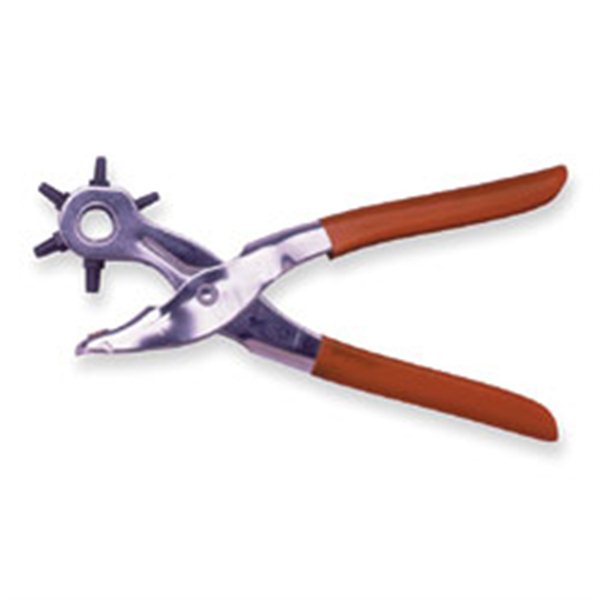
Revolving hole punch is convenient for doing the odd quick hole.
The advantage of the rotary hole punch is convenience. It comes with six different sizes of hole punches, which you switch between by rotating the wheel. We used to take this hand tool to craft shows to add a hole to a belt when someone would request it.
The disadvantage is that if you have many holes to punch, using the rotary punch pliers becomes tiring on the hand. It also will only reach about an inch in from the edge of your leather, so you can’t use it to punch a hole in the center of a large piece. Also, the thicker the leather and the larger the tube size, the harder it becomes to squeeze the revolving punch through. In these cases, sometimes you have to twist the punch some as you squeeze to get through the thicker leather. This leather tool is good for doing the odd hole, but too tiring and hard for punching lots of holes.
With this type of punch we again use a scrap piece of leather underneath the piece we want to punch, to keep the blades sharp. Otherwise you are crunching the sharp cutting tube into the hard metal anvil. Doing so will dull the tube quicker and wear out the metal anvil. Sandwich your good piece of leather and your scrap piece between the tube and the punching surface, and squeeze the handles together.
Punching Round Holes for Lacing

A four hole punch used for lacing.
Beyond the basic drive and rotary punches, you can find specialty leather punches for different applications. One of the more handy leather work tools is this four hole punch, which is used to make small holes for lacing leather. On this punch each hole is 3/32 inch diameter, spaced 1/4 inch apart. The advantage of the four-in-one punch is that it will save time and keep your holes evenly spaced. Use this four hole punch for the straight parts of your leather lacing project. For going around curves, use the single hole punch mentioned at the beginning of the article.
Use this hole puncher the same way as an individual drive punch. As with the oblong punch, you may need to tilt the punch to focus the force of the hammer on a particular hole.
The Video
Here you can watch Jamie demonstrating these leather craft tools. He shows how to punch a hole in a leather belt and other leatherwork projects in his custom leather shop.
Video demonstrating how to make holes in leather.

